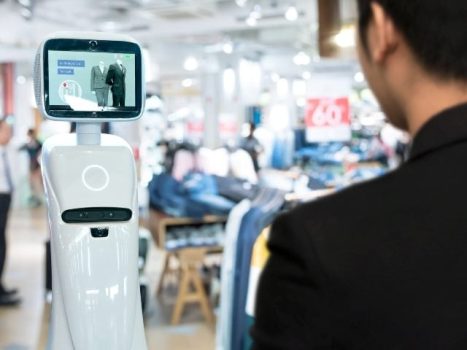Smart Tech, Smarter CX: Reshaping Expectations & Experiences

[ad_1]
The Gist
- Tech impact. Smart technologies significantly influence and shape customer experiences.
- Expectations shift. As tech advances, customer demands evolve for seamless, personalized experiences.
- Strategy needed. Successful tech integration requires clear objectives, resource investment and employee training.
When it comes to smart tech and consumer demands, one can argue there exists a “chicken and egg” sort of question. No doubt smart tech is constantly influencing customer expectations — but also, one of the key drivers in the rise of customer experience, as a whole, is the rise of smart tech, which has transformed the way customers interact with brands altogether.
With customer expectations rapidly evolving due to the integration of these advanced technologies, customer experience professionals must adapt to meet these demands and stay competitive. To do that effectively, let’s look at the impact of smart tech on CX, the future of customer expectations and how companies can truly excel in meeting rising demands.
The Future of Smart Tech
The term “smart tech” encompasses a range of technologies, such as artificial intelligence (AI), machine learning (ML), the Internet of Things (IoT), virtual reality (VR) and augmented reality (AR). These are the tools revolutionizing industries worldwide.
According to MarketsandMarkets, the global IoT market size is expected to reach $650.5 billion by 2026, with a compound annual growth rate (CAGR) of 16.7%. This massive growth in smart tech underscores its pivotal role in shaping the future of business — ultimately, by shaping customer experience.
One area where smart tech has already made a significant impact is in personalization. Of course, AI can provide real-time support to customers seeking assistance in the form of virtual assistants and bots. And despite the recent news stories, these technologies continue to be increasingly popular for their ability to provide personalized recommendations based on user preferences.
Furthermore, the integration of IoT devices (think wearable technology and smart home systems) has given companies access to valuable customer data that allows them to provide even more enhanced experiences. These insights have led to targeted marketing campaigns, personalized product recommendations and more relevant support interactions, which all contribute to overall customer experience.
One more example includes VR and AR, which have opened up new possibilities in experiential marketing and immersive CX. Companies can now create virtual showrooms or tours, giving customers a chance to engage with products or services like never before. These experiences have the potential to leave truly lasting impressions, with the hope ultimately being to drive brand loyalty.
So, that’s where we are now. But where are we headed?
Related Article: The Impact of Smart Tech on Customer Demands
What We Can Expect From Customer Expectations
As smart tech continues to advance and integrate into our everyday lives, customer expectations will also continue to undergo significant shifts.
Research by Salesforce has found that 75% of customers now expect a consistent experience whenever they engage with a brand, regardless of the channel or device they use. This demand for seamless, omnichannel experiences is just one example of how smart tech is impacting customer expectations.
Other areas where we can expect emerging technology to affect customer demands include:
- Even More Personalization: As mentioned earlier, smart tech has set a high bar for personalized interactions. Customers have come to expect tailored experiences, with 80% of them being more likely to do business with a company that offers personalized experiences, according to a survey by SmarterHQ.
- Speed and Convenience: Smart tech has enhanced the efficiency of customer service and support, with AI chatbots and virtual assistants reducing wait times and providing a near-instantaneous response. Customers now expect faster and more efficient assistance across all channels.
- Proactive Support: IoT devices and predictive analytics can give companies insights into potential customer needs before they even arise. My personal prediction is customers will increasingly expect brands to provide proactive support, anticipating their needs and offering preemptive solutions before “issues” even arise.
Related Article: How IoT, Automotive and SmartTV Are Changing the Digital Customer Experience
How to Leverage Smart Tech
Hopefully it’s clear by now that leveraging smart technology is essential for companies looking to stay ahead of the curve and maintain a competitive advantage. But like everything, strategy has to be involved from the onset.
To effectively harness the potential of smart tech, businesses must first identify their specific needs and objectives. How else will they ensure the technology they adopt aligns with their overall company goal? This requires a thorough understanding of the company’s competitive status and how it can be improved.
Additionally, businesses must be willing to invest in the necessary resources — including time, capital and personnel — to integrate new technologies and ensure their adoption. This is often the steepest hurdle. Remember as you move forward with pitching these new innovations to lead with the metric that begins with a dollar sign.
Successfully leveraging smart tech also requires a strong focus on employee training and development. As the implementation of AI, machine learning and automation often entails a shift in traditional workflows, businesses absolutely must provide their employees with the skills and knowledge needed to adapt to these changes.
Moreover, fostering a culture of innovation and continual improvement within the organization can help facilitate the adoption of smart technology, as internal teams will become more receptive to change and open to exploring new ways of functioning. This will empower them to transparently sell the customer on these same ideas.
Ultimately, by taking a strategic and proactive approach to adopting new, smart tech, companies are unlocking new opportunities, offerings and long-term growth.
Don’t let yours fall behind.
Learn how you can join our contributor community.
[ad_2]
Source link






